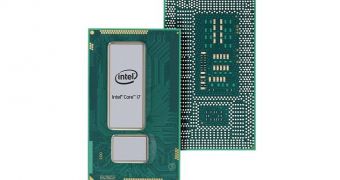Just a short time ago, we brought to your attention the unenviable fact (or at least rumor) that Intel had delayed the Broadwell-K line of high-end central processing units. Now, we can say that that set is not the only one going through this treatment.
According to the same source, Chinese VR-Zone website, the Core M “Broadwell-Y” processors will be pushed back as well. Or, rather, they already have been delayed.
The Core M “Broadwell-Y” chips, system-on-chip devices to be precise, are dual-core units with integrated 3 MB of L3 cache memory and HD graphics with 23 execution units.
They also boast dual-channel DDR3 memory controllers and Hyper-Threading support, making those two CPU cores appear as four in the Windows operating system. All this runs without bringing the TDP (thermal design power) over 4.5W to 11.5W.
It is obvious that the Core M Broadwell-Y SoCs could be used in a great many things, from tablets to media players, HTPCs, the Intel NUC, etc. However, it can also be used in low-priced laptops and embedded systems.
Initially, they were meant to debut this September, but they aren't expected to come out before December 2014 – January 2015 now. At least they weren't dragged all the way to mid-2015 or later, like the Broadwell-K.
Keep in mind that Intel hasn't officially stated the reasons for all these roadmap changes, and we suppose there is always a chance that the rumors aren't true. It's not likely though. The source usually gets these things right, and it's not like the delay of the main Broadwell chips hasn't already been confirmed.
It's only logical to push back everything else when the main money makers aren't going to come to market as planned. We just didn't expect the shifts to cause such bizarre conundrums.
The Core M Broadwell don't have many contenders, granted, but the Broadwell-K are pegged to market at the same time as the CPU generation meant to follow it, Skylake, and that is strange at the very least.
The poor chip yields recorded by the 14nm manufacturing process remain the most likely cause for the roadmap modifications. After all, jumping from the 22nm (Haswell) to 14nm is a tall order, since there won't be a stop by 16nm first.
Intel is actually fortunate that this is coming out after TSMC's 20nm debacle, which totally smashed NVIDIA's and AMD's plans to rubble. They had both prepared their upcoming architectures for 20nm, but TSMC announced it wouldn't be able to deliver this year, so the GPU makers had to totally rebuild the technology for 28nm.

 14 DAY TRIAL //
14 DAY TRIAL //